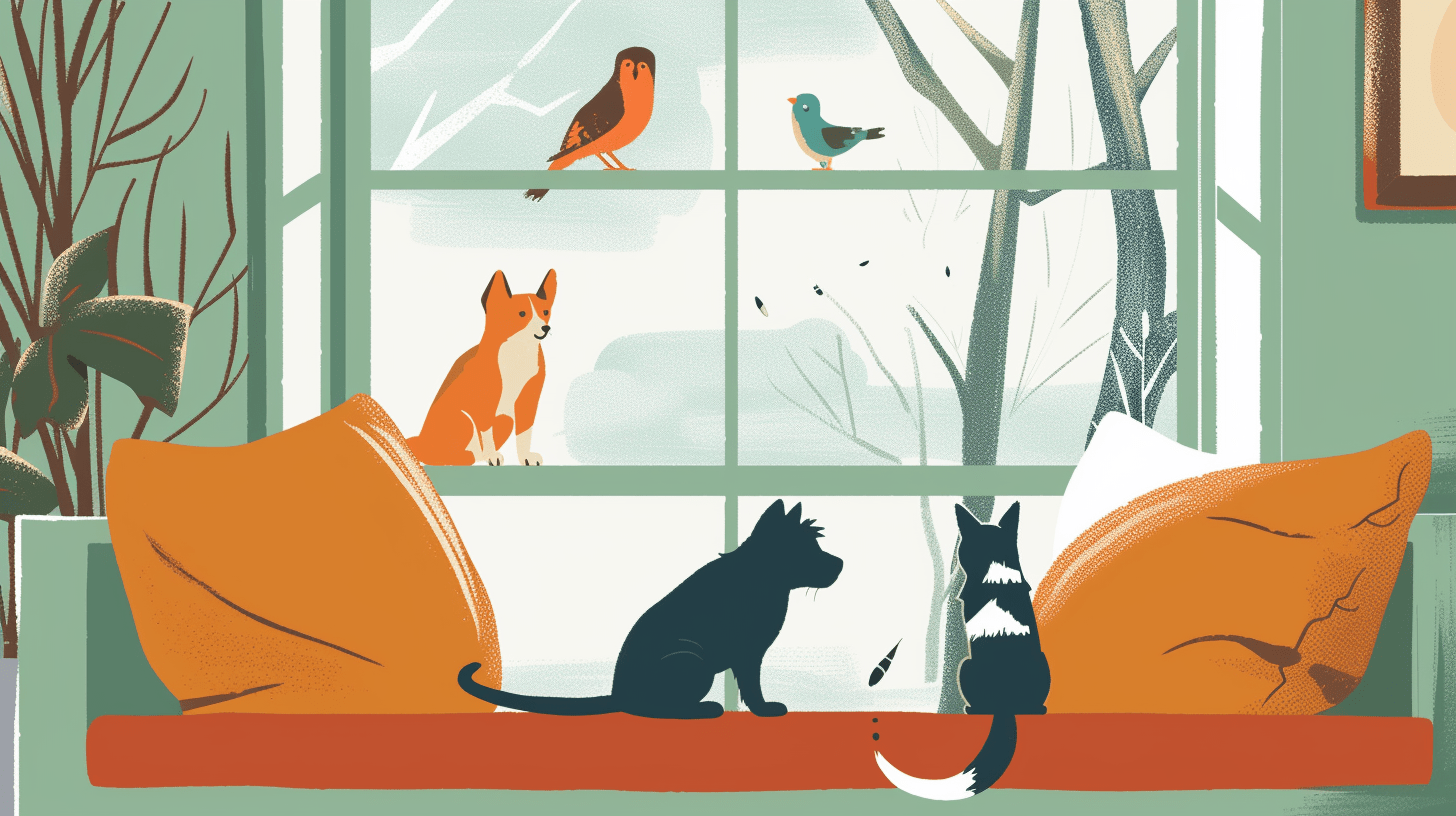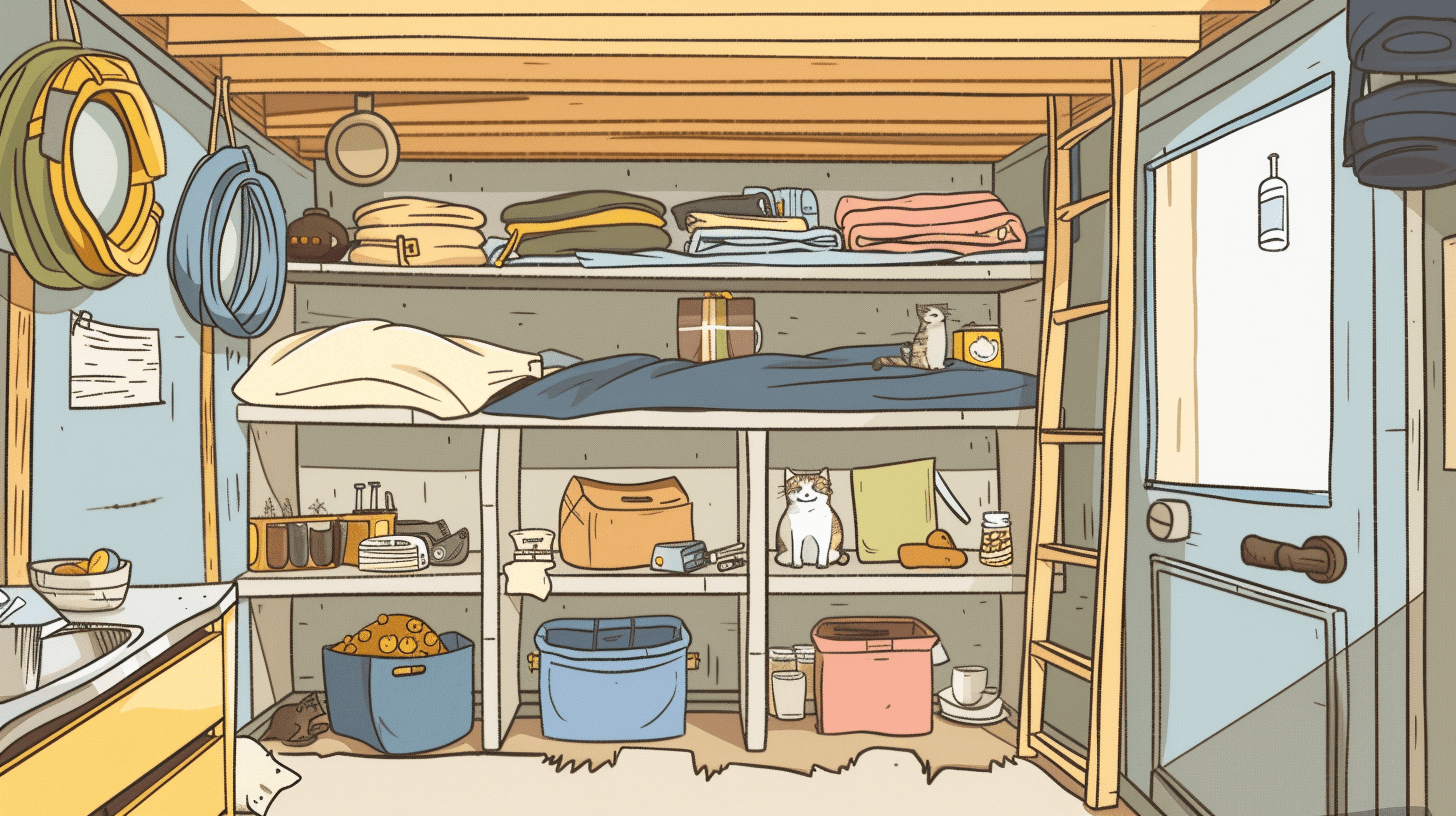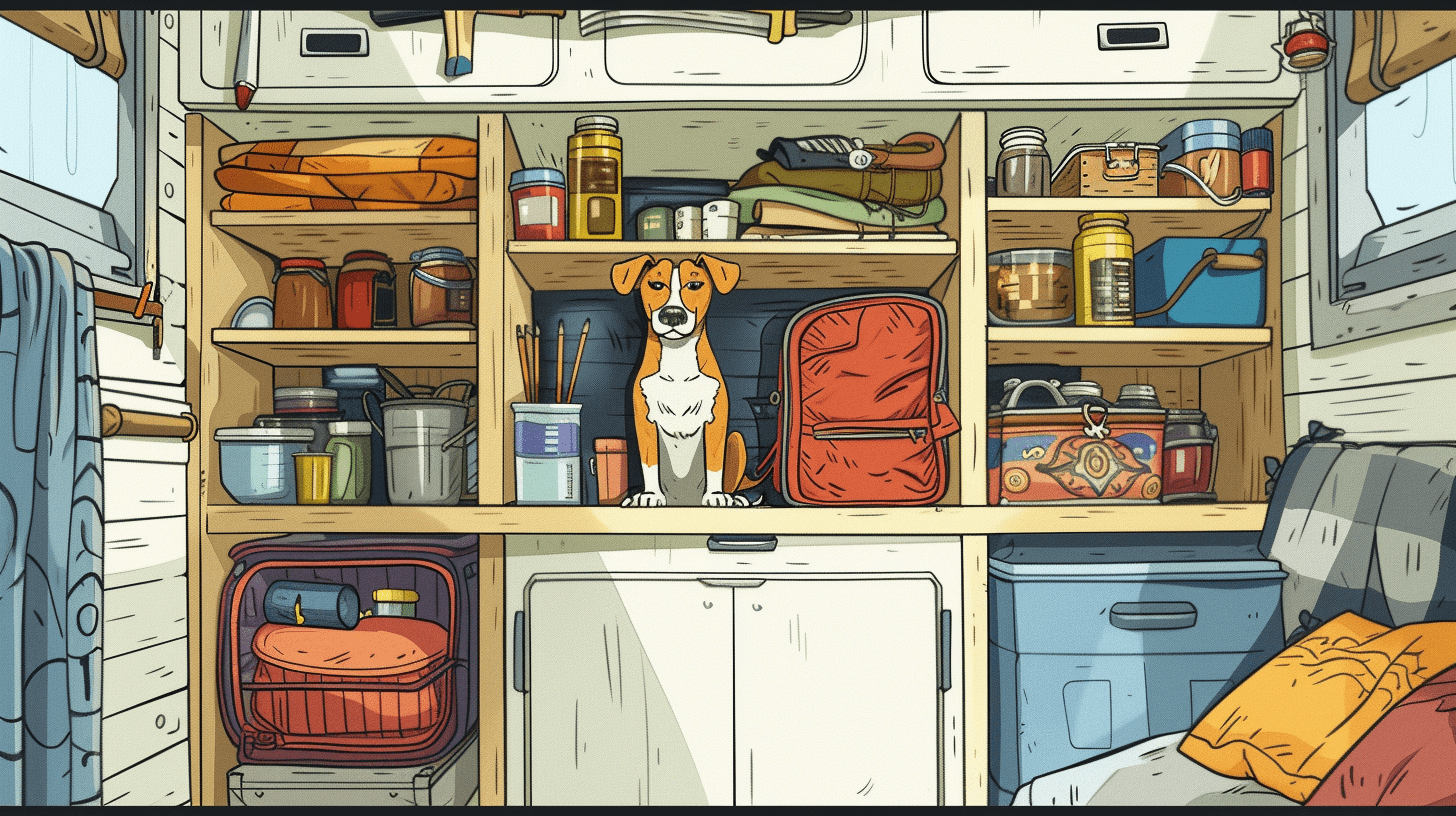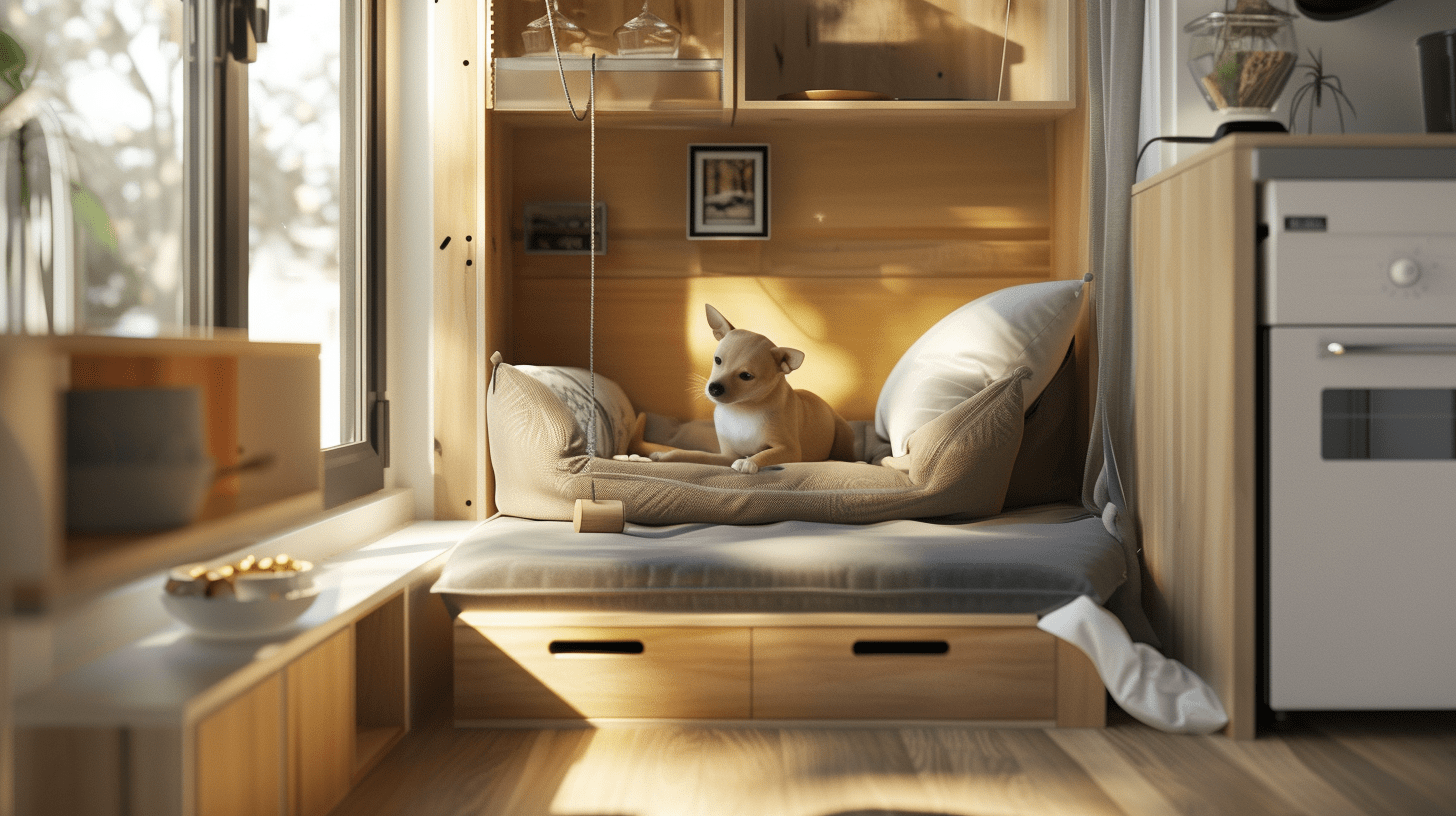Embarking on the journey of raising pets in a tiny home can feel like navigating a ship through narrow straits—challenging yet profoundly rewarding.
You’ve got to be inventive in managing the limited space without compromising your furry friend’s comfort or your sanity. From selecting the right pet that thrives in cozy settings to implementing space-saving designs that cater to both your needs, the process demands creativity and patience.
However, the joy of forming an unbreakable bond in such intimate quarters cannot be understated.
Let’s explore how to make this unique living situation a fulfilling experience for both you and your pet, and uncover the unexpected delights that tiny home living with pets has in store.
Selecting the Right Pet
When choosing a pet for your tiny home, it’s crucial to consider the animal’s size, activity level, and temperament to ensure a good fit with your living space and lifestyle. Tiny homes require tiny house pet-friendly companions that won’t feel cramped or overwhelmed in a smaller space. The size of your pet is paramount; a smaller pet can make living in a compact area more manageable and enjoyable for both of you.
You’ll also want to evaluate the activity level of potential pets. A high-energy pet mightn’t be the best match for a tiny house where space for running and playing is limited. Instead, look for pets that are content with less room to roam and can adapt to indoor living with ease.
Additionally, a pet’s temperament can significantly impact your tiny living experience. Opting for a pet that’s calm and adaptable can help make your space feel more harmonious. If you or anyone in your home has allergies, considering hypoallergenic pets could also be crucial. Finally, don’t forget to consider the training needs of your pet. Choosing a pet that can easily adapt to your tiny house living can make the transition smoother for both of you.
Space-Saving Design Tips
To maximize your tiny home’s living space for you and your pet, consider utilizing multipurpose furniture that serves double duty. Living in a small area with pets in a tiny home requires clever design and strategic planning. Here are some space-saving design tips to make the most of your room:
- Opt for Multipurpose Furniture: Choose pieces that offer storage solutions, such as a coffee table with hidden compartments for pet toys or a bench that doubles as a cat bed.
- Incorporate Built-in Storage: Utilize every inch of your tiny home by incorporating built-in storage for pet supplies. This keeps everything organized and out of sight, making your space feel less cluttered.
- Maximize Vertical Space: Install wall-mounted shelves or pet beds to free up floor space. This not only gives your pet their own space but also keeps your tiny home from feeling cramped.
- Select Foldable Accessories: Easy to clean, foldable or collapsible pet accessories can be stored away when not in use, ensuring your living area remains spacious and tidy.
Pet-Friendly Decorating
After mastering space-saving design tips for your tiny home, it’s crucial to focus on pet-friendly decorating to ensure both you and your pets enjoy a comfortable, stylish space. By choosing slip-resistant flooring like vinyl or tile, you’re laying the groundwork for a practical living area that’s safe for your furry companions to roam.
Opting for durable and easy-to-clean materials such as leather, microfiber, and cotton in your furniture selections isn’t only smart but ensures your space remains inviting and free from wear and tear.
Incorporating washable fabrics into your decor is a game-changer. It allows for easy clean-up after your pets and maintains a cozy space that’s welcoming for both humans and animals. Selecting pet-friendly furniture that withstands the test of time will keep your tiny home looking chic and stylish, without sacrificing comfort.
Safety and Security Measures
Ensuring the safety and security of your pets in a tiny home requires installing barriers and securing doors and windows effectively. Living in a compact space doesn’t mean compromising on pet safety. Here’s how you can create a secure environment for your pets:
- Installing Barriers: Use baby gates or screens to block off dangerous areas. This simple step prevents pets from wandering into places where they could get hurt.
- Securing Doors and Windows: Make sure all exits are equipped with sturdy latches or locks. It’s vital to prevent your pets from accidentally escaping and getting lost.
- Microchipping and GPS Collars: For an extra layer of security, consider microchipping your pets or using GPS collars. These tools can be lifesavers if your pet manages to wander off.
- Regular Inspection and Repairs: Conduct a regular inspection of your tiny home for potential hazards. Promptly repairing any damages ensures that your living space remains safe for your furry friends.
Cleanliness and Maintenance
While focusing on the safety and security of pets in a tiny home is crucial, it’s equally important to address cleanliness and maintenance to ensure a comfortable living environment for both you and your pets. Regular cleaning routines are not just a choice; they’re a necessity in a tiny home. To keep your space tidy and your pets happy, you’ll need to rely on high-quality, pet-safe cleaning products.
| Strategy | Benefit |
|---|---|
| Mats and Rugs | Trap dirt and debris, reducing the need for constant cleaning. |
| Litter Mats | Minimize litter scatter, keeping the area around the box neater. |
| Regular Grooming | Reduces shedding, helping maintain cleanliness in the home. |
Incorporating mats or rugs near entrances can significantly decrease the amount of dirt and debris your pets bring inside. Additionally, placing litter mats around litter boxes can help in containing the scatter and minimizing mess. But don’t forget about grooming; keeping your pets well-groomed and brushed regularly is crucial to reducing shedding and maintaining the overall cleanliness of your tiny home. Remember, a clean home is a happy home—for both you and your pets.
Managing Pet Supplies
Storing your pet’s supplies in a tiny home requires creativity and strategic planning to maximize limited space. Limited storage space can make managing pet supplies challenging, but with organization and creative storage solutions, you can keep everything in order.
Here are four strategies to effectively manage your pet supplies in a tiny home:
- Utilize Vertical Space: Install shelves and hanging organizers to take advantage of the vertical space in your home. This can free up floor space and keep pet supplies out of the way.
- Invest in Multipurpose Furniture: Look for furniture that serves double duty, such as an ottoman with storage inside for pet toys or a bench that doubles as a feeding station.
- Designate Specific Areas: Allocate specific areas in your home for pet supplies. This helps maintain a tidy and functional living space and makes it easier to find what you need.
- Regular Decluttering: Make a habit of regularly decluttering and organizing pet supplies. This step is essential to prevent overcrowding and ensures that your tiny home remains a comfortable and functional living space for both you and your pet.
Exercise and Stimulation
After organizing your pet supplies, it’s crucial to focus on keeping them healthy and happy through proper exercise and stimulation, even in a tiny home. With limited space, you’ll need creative solutions to ensure your furry friend stays active. Incorporating indoor play activities, like interactive toys, is a fantastic way to keep them mentally and physically engaged. These toys can challenge them, reduce boredom, and help maintain their well-being.
Designating specific play areas within your home encourages regular activity. Even a small corner can become a dedicated space for your pet’s playtime, making them feel secure and entertained. However, don’t overlook the importance of outdoor spaces. Pets thrive on variety, and outdoor activities offer a breath of fresh air, allowing them to explore and exercise in a different environment.
Balancing indoor and outdoor activities ensures your pet receives adequate stimulation and exercise, crucial for their health and happiness. It’s all about finding the right mix that suits the size of your living space and your pet’s needs. By being inventive and utilizing both indoor and outdoor opportunities, you can provide a fulfilling and active lifestyle for your pet, regardless of the size of your home.
Routine and Training
Establishing a consistent routine provides stability and peace of mind for your pets in a tiny home, setting the foundation for a harmonious living environment. Training your pets in such a confined space might seem daunting at first, but with patience and creative solutions, you can overcome behavior issues and enhance the bond between you and your pets.
Here are four essential tips to keep in mind:
- Integrate Training into Daily Activities: Use every opportunity to train your pets, turning routine activities into learning sessions. This helps in making the most of your limited space.
- Employ Positive Reinforcement: Always reward good behavior with treats, praise, or playtime to encourage consistency and foster a positive relationship.
- Set a Consistent Schedule: Pets thrive on routine. Feeding, walking, and training sessions at the same times each day can significantly reduce stress and promote harmony.
- Be Creative with Space: Find innovative ways to conduct training sessions, even in a small area. This could involve using vertical space or multi-functional furniture.
Overcoming Space Challenges
Navigating the tight quarters of a tiny home requires clever strategies to ensure your pets have everything they need without cluttering your space. Tiny house living comes with its set of space challenges, especially when accommodating pets in small spaces. You’ll need to think outside the box, employing creative storage solutions and strategic planning to create a comfortable environment for your furry friends.
One effective approach involves designing designated areas for your pet’s needs. Carve out a specific corner or nook for feeding stations, litter boxes, and cozy beds. This can help keep pet supplies organized and out of the way. Consider built-in pet beds or wall-mounted shelves to maximize floor space, and opt for multipurpose furniture that can serve both you and your pets.
Don’t forget the importance of utilizing outdoor spaces. A small patio or yard can be a great extension of your living area, offering additional room for exercise and play. With a bit of creativity and organization, you can overcome the challenges of tiny house living, ensuring your pets aren’t only accommodated but thrive in small spaces.
The Bond of Tiny Living
Living in a tiny home, you’ll quickly discover that the close quarters foster an unparalleled bond between you and your pets, transforming challenges into cherished moments of togetherness. The essence of tiny living isn’t just about making do with less; it’s about the profound connection that blossoms in such an intimate setting.
Here are four key aspects that highlight the bond of tiny living:
- Constant Companionship: Your pets are more than just roommates; they’re your constant companions. This close proximity means you’re always within reach for a cuddle or a playful break, ensuring you maintain a bond that’s hard to replicate in larger spaces.
- Deeper Connections: The limited space necessitates closer interaction, allowing pet owners to understand their pets’ needs and personalities on a deeper level. This mutual reliance fosters a relationship built on understanding and empathy.
- Cozy Living Environment: Sharing a small, cozy space means warmth and comfort are always within arm’s reach, for both you and your pets. This coziness enhances the sense of togetherness.
- Mutual Reliance: The unique dynamic of raising pets in a tiny home promotes a sense of mutual reliance. You depend on each other for company and entertainment, strengthening your relationship.
Conclusion
Living in a tiny home with your pet may have its challenges, from finding the right space-saving solutions to ensuring their safety and comfort. Yet, it’s these very challenges that can deepen the bond between you and your furry friend.
By embracing creative designs, maintaining routines, and prioritizing their well-being, you’ll discover the immense joy and companionship pets bring into small spaces.
Remember, it’s not the size of the home but the love within that makes it a haven for you both.





